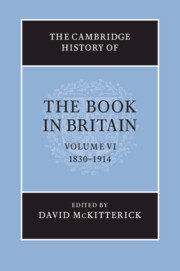Crossref Citations
This Book has been
cited by the following publications. This list is generated based on data provided by Crossref.
Cachin, Marie-Françoise
2010.
Une nation de lecteurs ?.
p.
231.
Fulsås, Narve
2011.
Ibsen Misrepresented: Canonization, Oblivion, and the Need for History.
Ibsen Studies,
Vol. 11,
Issue. 01,
p.
3.
LITVINE, ALEXIS D.
2014.
THE INDUSTRIOUS REVOLUTION, THE INDUSTRIOUSNESS DISCOURSE, AND THE DEVELOPMENT OF MODERN ECONOMIES.
The Historical Journal,
Vol. 57,
Issue. 2,
p.
531.
Hensley, Nathan K.
2014.
What is A Network? (And Who is Andrew Lang?).
Romanticism and Victorianism on the Net,
2015.
‘Illustrated Picturesquely and Architecturally in Photography’: William J. Stillman and the Acropolis in Word and Image.
Architectural Histories,
Vol. 3,
Issue. 1,
janes, dominic
2016.
The Wordless Book: The Visual and Material Culture of Evangelism in Victorian Britain.
Material Religion,
Vol. 12,
Issue. 1,
p.
26.
Watt, Paul
Scott, Derek B.
and
Spedding, Patrick
2017.
Cheap Print and Popular Song in the Nineteenth Century.
p.
1.
Geslot, Jean-Charles
2018.
L’édition française à l’heure de la science anglaise dans la deuxième moitié du xixe siècle : Thomas Henry Huxley.
Philosophia Scientae,
p.
63.
2019.
The Book in Britain.
p.
461.
Mollier, Jean‐Yves
and
Cachin, Marie‐Françoise
2019.
A Companion to the History of the Book.
p.
485.
Banham, Rob
2019.
A Companion to the History of the Book.
p.
95.
Banham, Rob
2019.
A Companion to the History of the Book.
p.
453.
Wilfert-Portal, Blaise
2020.
Literary Translation in Periodicals.
Vol. 155,
Issue. ,
p.
21.
Magnusson, Danielle
and
Cleaver, Laura
2022.
The Trade in Rare Books and Manuscripts between Britain and America <I>c</I>. 1890–1929.
O’Hagan, Lauren Alex
2022.
The Palgrave Handbook of Digital and Public Humanities.
p.
275.
Cooke, Nathalie
and
Litvack-Katzman, Ronny
2024.
Open Times: The future of critique in the age of (un)replicability.
International Journal of Digital Humanities,
Vol. 6,
Issue. 1,
p.
71.



